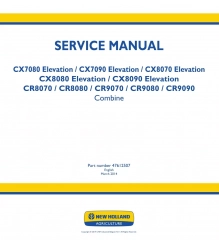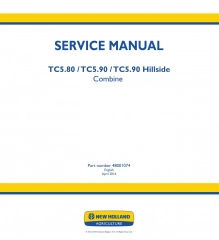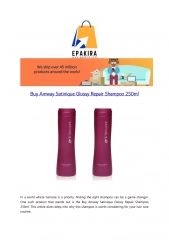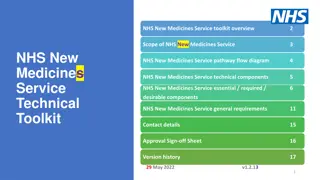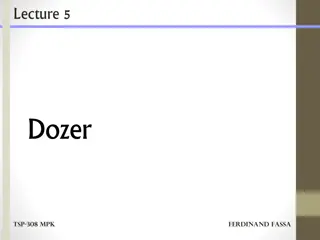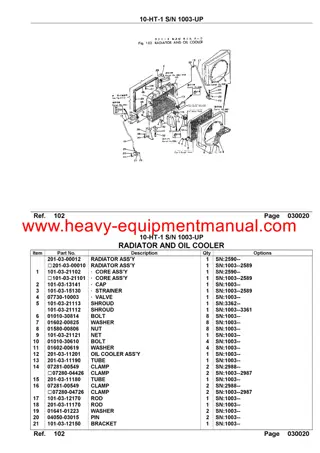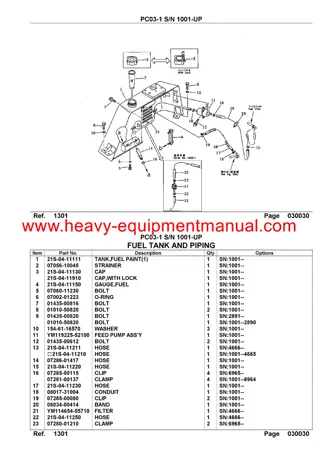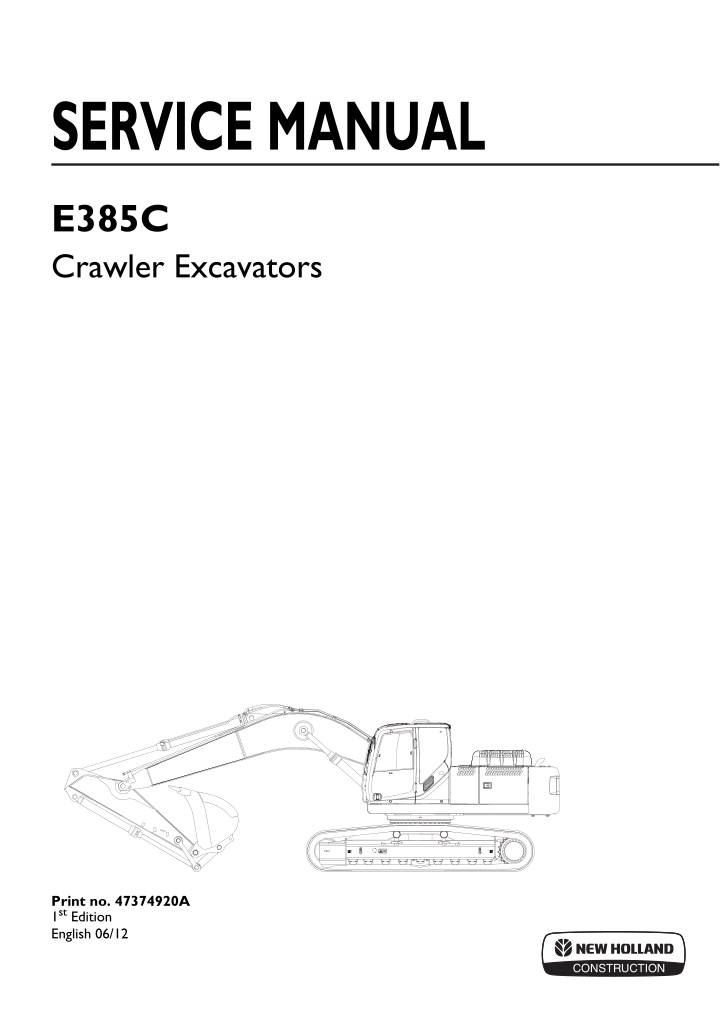
New Holland E385C Crawler Excavator Service Repair Manual Instant Download
New Holland E385C Crawler Excavator Service Repair Manual Instant Download
Download Presentation

Please find below an Image/Link to download the presentation.
The content on the website is provided AS IS for your information and personal use only. It may not be sold, licensed, or shared on other websites without obtaining consent from the author. If you encounter any issues during the download, it is possible that the publisher has removed the file from their server.
You are allowed to download the files provided on this website for personal or commercial use, subject to the condition that they are used lawfully. All files are the property of their respective owners.
The content on the website is provided AS IS for your information and personal use only. It may not be sold, licensed, or shared on other websites without obtaining consent from the author.
E N D
Presentation Transcript
SERVICE MANUAL E385C Crawler Excavators Print no. 47374920A 1st Edition English 06/12 CONSTRUCTION
WARNING Read this manual before operating the machine Most accidents occurring during work are due to non-observance of simple safety norms and elementary precautions. Many accidents can be avoided if the causes are known and opportune cautions taken beforehand. There is no device or protection, no matter how advanced, that may prove so effective at avoiding accidents as a careful and attentive behaviour. WARNING Ensure that the attachment is safely resting onto the ground before repairing, adjusting or servicing machines fitted with hydraulically, mechanically or cable controlled attachments (such as, excavators, loaders, dozers, scrapers, etc.). Should it be necessary to partially or fully raise the hydraulically, mechanically or cable controlled attachment to gain access to certain items, make sure the attachment is adequately retained in the raised position by means other than the hydraulic lift cylinders, cables and/or mechanical devices used for controlling it. COPYRIGHT BY NEW HOLLAND KOBELCO CONSTRUCTION MACHINERY S.p.A. Product Support Strada di Settimo, 323 - S. MAURO T.SE ( TO ) ITALY
E385C INTRODUCTION PAGE NUMBER Each page has a number, located on the central lower side of the page. Each page number contains the following information: Example: T 1-2-3 Consecutive page number for each group Group number (if exist)) Section number T: Technical Manual W: Workshop Manual SYMBOLS In this manual, the following safety alert symbol and signal words are used to alert the reader to the potential for personal injury or machine damage. This is the safety alert symbol. When you see this symbol, be alert to the potential for personal injury. Never fail to follow the safety instructions prescribed along with the safety alert symbol. The safety alert symbol is also used to draw attentio in to component/part weights. To avoid injury and damage, be sure to use appropriate lifting techniques and equipment when lifting heavy parts. UNITS USED SI Units (International System of Units) are used in this manual. MKSA system units and English units are also indicated in parentheses just behinds SI units. Example: 24.5 MPa (250 kgf/cm2) A table for conversion from SI units to other system units is shown below for reference purposes. To convert from (SI) mm Into To convert from (SI) MPa Into Quantity Multiply by Quantity Multiply by (Others) in (Others) Lenght 0.03937 Pressure 10.197 kgf/cm2 mm ft 0.003281 MPa psi 145.0 Volume L US gal 0.2642 Power kW CV-PS 1.360 L US qt 1.057 kW HP 1.341 1.308 Temperature C F C x 1.8 + 32 m3 yd3 Mass kg lb 2.205 Velocity km/h mph 0.6214 Force N kgf 0.10197 rpm 1.0 min-1 N lbf 0.2248 Flow rate L/min US gpm 0.2642 Torque N.m kgf.m 0.10197 mL/rev cc/rev 1.0 N.m lbf.ft 0.7375 IN - 2
https://www.ebooklibonline.com Hello dear friend! Thank you very much for reading. Enter the link into your browser. The full manual is available for immediate download. https://www.ebooklibonline.com
INDEX E385C MANUAL INDEX GENERAL SAFETY INFORMATION Page Section 1 SAFETY INFORMATION .......................................................S1 Section 2 SAFETY PRECAUTIONS ......................................................S2 Section 3 SAFETY DECALS..................................................................S3 OPERATIONAL PRINCIPLE Section 1 GENERAL INFORMATION Group 1 Specifications.................................................................................T1-1 Section 2 SYSTEM Group 1 Group 2 Group 3 Mechatro Control System ..............................................................T2-1 Hydraulic System...........................................................................T2-2 Electrical System ...........................................................................T2-3 Section 3 COMPONENT OPERATION Group 1 Hydraulic Pump Assy.....................................................................T3-1 Group 2 Pilot Valve......................................................................................T3-2 Group 3 Control Valve .................................................................................T3-3 Group 4 Swing Device.................................................................................T3-4 Group 5 Travel Device.................................................................................T3-5 Group 6 Swivel Joint....................................................................................T3-6 Group 7 Cylinders........................................................................................T3-7 Group 8 Air Conditioner system...................................................................T3-8 Group 9 Electrical Equipment......................................................................T3-9 OPERATIONAL PERFORMANCE TEST Section 4 OPERATIONAL PERFORMANCE TEST Group 1 Introduction ...................................................................................T4-1 Group 2 Standard Performances.................................................................T4-2 Group 3 Test Procedures ............................................................................T4-3 Group 4 Mechatro Controller.......................................................................T4-4 TROUBLESHOOTING Section 5 TROUBLESHOOTING Group 1 Troubleshooting (by error codes)...................................................T5-1 Group 2 Troubleshooting (by trouble)..........................................................T5-2
E385C INDEX REPAIR INSTRUCTIONS Section 1 GENERAL INFORMATION Group 1 Precautions for Disassembly and Assembly.................................W1-1 Group 2 Tightening Torque ........................................................................W1-2 Section 2 UPPERSTRUCTURE Group 1 Upperstructure..............................................................................W2-1 Group 2 Pump Device.................................................................................W2-2 Group 3 Control Valve ................................................................................W2-3 Group 4 Swing Device ...............................................................................W2-4 Group 5 Pilot Valve .....................................................................................W2-5 Section 3 UNDERCARRIAGE Group 1 Swing Bearing ..............................................................................W3-1 Group 2 Travel Device ...............................................................................W3-2 Group 3 Swivel Joint ..................................................................................W3-3 Group 4 Track Adjuster ..............................................................................W3-4 Group 5 Front Idler .....................................................................................W3-5 Group 6 Upper and Lower Roller ...............................................................W3-6 Group 7 Tracks ...........................................................................................W3-7 Section 4 FRONT ATTACHMENT Group 1 Front attachment...........................................................................W4-1
SAFETY INFORMATION E385C SAFETY RULES GENERALITIES Always check height, width and weight limitations which may be encountered in the working site and ensure the machine does not exceed them. Assess exact paths of gas ducts, water mains, telephone lines, sewers, overhead and underground electric lines and all other possible obstacles. Such paths should be opportunely defined by competent Authorities. If necessary, require that the service is interrupted or said installations are moved prior to starting the work. Define the rear upperstructure swing area and provide for opportune barriers to prevent access into it. Never exceed machine lifting capacity. Remain within the limits shown in the loading capacity chart which located on the machine. Read the Operator's manual carefully before starting, operating, maintaining, fuelling or servicing the machine. Carefully read the explanation to each and all safety signs in the special section of this Manual before starting, operating, maintaining, fuelling or servicing the machine. Machine-mounted safety decals are colour coded yellow with black borders when they refer to points where special ATTENTION must be paid and failure to observe them may cause a serious DANGER to the integrity of machine operators. It is fundamental that all machine operators know very well the meaning of each safety plate as this considerably decreases operating hazards and accidents. Do not allow unauthorised personnel to operate or service this machine. Do not wear rings, wrist watches, jewellery, loose or hanging garments, such as ties, torn clothing, scarves, unbuttoned or unzipped jackets that can get caught in moving parts. Wear certified safety clothes such as: hard hat, no-slip footwear, heavy gloves, ear protection, safety glasses, reflector vests, respirators every time the job requires it. Ask your employer about safety regulations in force and protective equipment. Always keep the operator s compartment, step plates, grab-rails and handles clean and clear of foreign objects, oil, grease, mud or snow to minimise the danger of slipping or stumbling. Remove mud or grease from your shoes before operating the machine. Do not jump on or off the machine. Always keep both hands and one foot, or both feet and one hand in contact with steps and/or grab rails. Do not use controls or hoses as hand holds. Hoses and controls are movable parts and do not provide solid support. Besides, controls may be inadvertently moved and cause unexpected movement of the machine or its attachments. Never operate the machine or its attachments from any position other than sitting in the driver s seat. Keep head, body, limbs, hands and feet inside the operator s compartment at all times to reduce exposure to external hazards. Be careful of possible slippery conditions of the steps and hand rails as well as of the ground around the machine. Wear protective boots or shoes with the soles made of highly no-slip rubber Do not leave the machine until it has come to a complete stop. STARTING Never start or operate a failed machine. Walk all around the machine before mounting. Before operating the machine, make sure that any possible dangerous condition has been properly removed. Before starting machine, always check that all controls are in the neutral position and the safety lever is in the LOCK position. Immediately report any malfunction of parts or systems to the maintenance managers for proper action. Prior to starting the engine, check, adjust and lock the driver s seat for maximum riding comfort and control accessibility. Prior to operating the machine and/or its attachments, check that bystanders are outside the machine operating range. Sound the horn. Obey all hand signals, safety indications and signs. Due to the presence of flammable fluids, never check fuel level, refuel, charge the batteries in the presence of smoking materials, open flames or sparks. Adjust all rear-view mirrors for maximum visibility of the area behind the machine. Ensure that engine speed is appropriate to the job to be carried out. If any hydraulic control or system exhibits erratic performance or responds abnormally, have the machine checked for air in the system. Air in these circuits may cause incorrect movements with consequent accident hazard. Refer to the Operator's manual about corrective action to be taken. S1 - 1
E385C SAFETY INFORMATION report this problem to the maintenance managers for proper action. Do not operate the machine until this condition is corrected. Regularly check all exhaust system components, as exhaust fumes are toxic for the operator. Operators must know the performance of the machine they are driving. When working on slopes or near sudden level drops in the terrain, pay attention not to lose adherence and avoid loose soft ground since overturn or loss of machine control could result. If noise level is high and exceeds 90 dB (A) over 8 hours at the operator s ear, wear approved ear protection in compliance with local regulations. Do not operate the machine if you are extremely tired or feel ill. Be especially careful towards the end of the working shift. Where removable counterweights are provided, do not operate the machine if they have been removed. When operating the machine, keep in mind height limits of overhead doors, arches, overhead cables and lines as well as width limits of corridors, roads and narrow passages. Also, get to know load limits of the ground and paving type of the ramps you are to work on. Beware of fog, smoke or dust that obscure visibility. Always inspect the working area to identify potential risks such as: inclines, overhangs, trees, demolition rubble, fires, ravines, steep slopes, rough terrain, ditches, crowns, ridge trenches,diggings in traffic areas, crowded parking lots, crowded service areas, fenced zones. In such conditions, proceed with extreme care. Whenever possible, avoid crossing over obstacles such as very rough terrain, rocks, logs, steps, ditches, railroad tracks. When obstructions must be crossed, do so with extreme care and at a square angle, if possible. Slow down. Ease up to the break-over point, pass the balance point slowly and ease down the other side also using the attachment, if necessary. To overcome deep trenches or sinking ground, place the machine perpendicular to the obstacle, drastically reduce ground speed and start crossing using also the attachment if necessary, only after assessing that ground conditions allow the traverse safely and without risks. The gradient you may attempt to overcome is limited by factors such as ground conditions, load being handled, machine type and speed, and visibility. There is no substitute for good judgement and experience when working on slopes. Avoid operating the attachment too close to an overhang or high wall, either above or below the machine. Beware of caving edges, falling objects and landslides. Remember that such hazards are OPERATING Do not run the engine in closed buildings without proper ventilation capable to remove harmful exhaust gases which concentrate in the air. Keep the operator s compartment free of foreign objects, especially if not firmly secured. Never use the machine to transport objects, unless proper securing points are provided. Do not carry riders on the machine. Study and familiarise with escape routes alternative to normal exit routes. For your personal safety, do not climb on or off the machine while it is in motion. Make sure that bystanders are clear of the machine operating range before starting the engine and operating the attachment. Sound the horn. Obey all hand signals, safety indications and signs. When backing, always look to where the machine is to be moved. Be alert of the position of bystanders. Should someone enter the work area, stop the machine. Maintain a safe distance from other machines or obstacles to ensure required visibility conditions. Always give way to loaded machines. Maintain a clear vision of the surroundings of the travel or work area at all times. Keep cab windows clean and repaired. When pulling loads or towing through a cable or chain, do not start suddenly at full throttle. Take-up slack carefully. Avoid kinking or twisting chains or cables. Carefully inspect the towing items for flaws or problems before proceeding. Do not pull through a kinked chain or cable as the high anomalous stresses existing in this condition may induce failures in the kinked portion. Always wear heavy gloves when handling chains or cables. Chains and cables should be securely anchored using suitable hooks. Anchor points should be strong enough to withstand the expected load. Keep anyone clear of anchor points and cables or chains. Do not pull or tow unless the operator s compartments of the machines involved are properly protected against possible backlash in case of cable or chain failure or detachment. Be alert of soft ground conditions close to newly constructed walls. The fill material and machine weight may cause the wall to collapse under the machine. In darkness, check area of operation carefully before moving in with the machine. Use all lights provided. Do not move into low visibility areas. If the engine tends to slow down and stall for whatever reason under load or at idle, immediately S1 - 2
SAFETY INFORMATION E385C lay building components, special caution must be taken as follows: likely to be concealed by bushes, undergrowth and such. Avoid bushes, logs and rocks. Never drive over them, nor over any other surface irregularities that discontinue adherence or traction with the ground, especially near slopes or drop-offs. Be alert to avoid changes in adherence conditions that could cause loss of control. Work with extreme care on ice or frozen ground and on stepped slopes or near drop-offs. The word bulldozing generally refers to work in virgin rough terrain, characterised by the presence of all the perils and risks listed above. We emphasise the danger represented in these conditions by large tree limbs (possibly falling on the machine) and large roots (which may act as a leverage under the machine when up-rooted and cause the unit to overturn). Position the machine dependent upon the loading and unloading areas in order to swing leftwards to load to obtain best visibility. Never use the bucket or attachment as a man lift or carry riders. Never use the machine as a work platform or scaffolding. The machine must not be improperly used for works not consistent with its features (such as pushing railway cars, trucks or other machines). Always pay attention to people within the machine operating range. Never move or stop the bucket, other loads or the attachment above ground personnel or truck cabs. Ensure the truck driver is in a safe place before loading the truck. Load trucks from side or rear. Use only the type of bucket recommended considering machine type, materials to be handled, material piling up and loading characteristics, ground type and other typical conditions of the work to be performed. When transporting a loaded bucket, keep it as rolled-back as possible. Keep boom and arm as low as possible. Ground speed should be adequate to the load and ground conditions. The load must always be properly arranged in the bucket; move with extreme care when transporting oversize loads. Do not lift and move the bucket overhead where persons are standing or working, nor downhill when working on a slope as this would decrease machine stability. Load the bucket from the uphill side. Loads to be raised using the machine should be exclusively hooked to the hitch specially provided. The excavator is no lifting and transportation means, therefore it should not be used to position loads accurately. Should it be exceptionally used to lift and - The machine must be equipped compulsorily with the appropriate variant provided upon request. - Secure the loads to be raised using cables or chains fastened with mechanisms. - Nobody should be allowed to remain under the raised load or within the excavator operating range for any reason whatever. appropriate hooking Never exceed specified loading capacity. Incorrect fastening of slings or chains may cause boom/arm failure or failure of the lifting means with consequent bodily injuries and even death. Always ensure that slings and chains used for lifting are adequate to the load and in good condition. All loading capacities are referred to the machine on a level surface and should be disregarded when working on a slope. Avoid travelling across slopes. Proceed from uphill downhill and vice-versa. If machine starts slipping sideways when on a slope, lower the bucket and thrust bucket teeth into the ground. Working on slopes is dangerous. Grade the working area if possible. Reduce work cycle time if it is not possible to grade the working area. Do not move full bucket or a load from uphill downhill as this would reduce machine stability. Do not work with the bucket turned to the uphill side. Do not work with the bucket turned uphill as counterweights protruding downhill would reduce machine stability on the slope and increase risk of overturning. We recommend to work on slopes with the bucket downhill, after checking machine stability with the bucket empty and attachment retracted, by slowly swinging the upper structure by 360 . Position the carriage at a right angle relative to slopes, hanging walls, etc. to exit the working area easily. Keep the machine sufficiently far from the ditch edge. Never dig under the machine. Should it be necessary to dig under the machine, always ensure that digging walls are opportunely propped up against landslide to prevent the machine from falling into the trench. Do not swing the upperstructure, raise the load or brake abruptly if not required. This may cause accidents. Prior to beginning the work near gas distribution mains or other public utilities: S1 - 3
E385C SAFETY INFORMATION - Appoint a person in charge of signalling duties. This person will have the responsibility of observing the machine, any part of it and/or the load approaching the electric lines from a standpoint more favorable than the Operator. This signal man (flag-man) must be in direct communication with the Operator and the Operator must pay undivided attention to the signals supplied. When working in or near pits, in ditches or very high walls, check that the walls are sufficiently propped up to avoid cave-in hazards. Pay the utmost attention when working near overhang walls or where landslides may take place. Make sure that the support surface is strong enough to prevent landslides. When digging, there is the risk of cave-ins and landslides. Always check ground conditions and conditions of the material to be removed. Support everywhere it is required to prevent possible cave-ins or landslides when: - Digging near previous trenches filled with material. - Digging in bad ground conditions. - Digging trenches subject to vibration from railroads, working machines or highway traffic. - Contact the company owner of the gas mains or its nearest branch before starting the work. - Define together which precautions should be taken to guarantee work safety. - Decrease work speed. Reaction time could be too slow and distance evaluation wrong. - When working near gas mains or other public utilities installations, appoint a person in charge of signalling duties. This person will have the responsibility of observing the machine, any part of it and/or the load approaching the gas mains from a standpoint more favorable than the Operator. This signal man (flag-man) must be in direct communication with the Operator and the Operator must pay undivided attention to the signals supplied. - The gas distributing Company, if previously advised and involved in the work, as well as machine Operator, Owner and/or any natural person or legal entity having rent or leased the machine or being responsible at the time by contract or by law, are liable for the adoption of the necessary precautions. Working near electric lines can be very dangerous, therefore some special precautions must be observed. Within this Manual, work near electric lines means when the attachment or load raised by the excavator (in any position) may reach the minimum safety distance established by local or international Safety Regulations. To work without risks, keep maximum possible distance from electric lines and never trespass minimum safety distance. - Contact the Company owner of the electric lines or its nearest branch before starting the work. - Define together with the Company representative which precautions should be taken to guarantee work safety. - All electric lines should be considered as operative live lines even though it might be well known that the line in question is out of work and visibly connected to the ground. - The Electric Power Company, if previously advised and involved in the work, as well as machine Operator, Owner and/or any natural person or legal entity having rent orleased the machine or being responsible at the time by contract or by law, are liable for the adoption of the necessary precautions. - Decrease work speed. Reaction time could be too slow and distance evaluation wrong. - Warn all ground personnel to keep clear of the machine and/or load at all times. If the load has to be guided down for laying, consult the Electric Power Company to know which precautions should be taken. STOPPING When the machine is to be stopped for whatever reason, always check that all controls are in the neutral position and that the safety lever is on the lock position to guarantee risk-free start-up. Never leave the machine unattended with the engine running. Prior to leaving the driver s seat, and after making sure that all people are clear of the machine, slowly lower the attachment until resting it safely to the ground. Retract possible auxiliary tools to the closed safety position. Check that all controls are in the neutral position. Move engine controls to the shut-down position. Switch off the key-start switch. Park the machine in a non-operating and no-traffic area. Park on firm level ground. If this is not possible, position the machine at a right angle to the slope, making sure there is no danger of uncontrolled sliding. If parking in traffic lanes cannot be avoided, provide appropriate flags, barriers, flares and other signals as required to adequately warn the oncoming drivers. Always switch off the key-start switch before cleaning, repairing, or parking the machine to prevent accidental unauthorised start-up. Never lower the attachment or auxiliary tools other than from sitting in the operator s seat. Sound the S1 - 4
OPERATIONAL PRINCIPLE E385C SECTION AND GROUP CONTENTS Section 1 GENERAL INFORMATION Group 1 Specifications Section 2 SYSTEM Group 1 Group 2 Group 3 Mechatro Control System Hydraulic System Electrical System Section 3 Group 1 Group 2 Group 3 Group 4 Group 5 Group 6 Group 7 Group 8 Group 9 COMPONENT OPERATION Hydraulic Pump Assy Pilot Valve Control Valve Swing Device Travel Device Swing Joint Cylinders Air Conditioner Electrical Equipment
SECTION 1 E385C GENERAL INFORMATION CONTENTS Group 1 - Specifications Machine main components................ T1-1-1 Hydraulic components ....................... T1-1-5 Performance ...................................... T1-1-8 Engine specifications......................... T1-1-8 Engine characteristic curve................ T1-1-10 Digging data ...................................... T1-1-12 Dimensions and weights.................... T1-1-14 Buckets application as a function of the arm .......................................... T1-1-16 Fluids and lubricants.......................... T1-1-17
SECTION 2 E385C SYSTEM CONTENTS Group 1 - Mechatro Control System 5 Proportional hand control Extra hydraulic circuit with pressure unload (optional)............................................T2-2-8 6 Boom lowering hydraulic circuit (optional)............................................T2-2-10 7 Color coding standard for hydraulic circuits................................................T2-2-12 8 Neutral circuit ....................................T2-2-12 9 Travel circuit ......................................T2-2-14 10 Bucket circuit .....................................T2-2-16 11 Boom circuit ......................................T2-2-18 12 Swing circuit ......................................T2-2-22 13 Arm circuit .........................................T2-2-24 14 Combined circuit ...............................T2-2-30 15 Pressure draining (releasing) circuit .T2-2-34 1 Preface .............................................. T2-1-1 2 Summary of Mechatro control systemT2-1-2 2.1 Mechatro control system in general ..................................... T2-1-2 2.2 Unload valve control................. T2-1-4 2.3 Positive control & P-Q control... T2-1-6 2.4 Boom up conflux control........... T2-1-8 2.5 Arm in recirculation & conflux control....................................... T2-1-10 2.6 Arm-in anti-cavitation control.... T2-1-12 2.7 Arm-out conflux control............. T2-1-13 2.8 Bucket digging (dump) conflux control....................................... T2-1-14 2.9 Bucket digging anti-cavitation control....................................... T2-1-16 2.10 Swing priority control ................ T2-1-18 2.11 Travel straight control............... T2-1-20 2.12 Pressure release control........... T2-1-22 2.13 N&B switch control (option) ...... T2-1-24 2.14 Option conflux control (option).. T2-1-25 Group 3 - Electrical system Electrical system main components........T2-3-1 Electrical system (Overall system).....T2-3-1 Electrical system diagram ......................T2-3-14 Electrical system diagram (No. 1)......T2-3-14 Electrical system diagram (No. 2)......T2-3-16 Electrical system diagram (No. 3)......T2-3-18 Electrical system diagram (No. 4)......T2-3-20 Electrical system diagram (No. 5)......T2-3-22 Wiring harness........................................T2-3-24 Cluster gauge wiring harness assembly...................................T2-3-25 Platform wiring harness assembly ....T2-3-27 Upper frame wiring harness assembly.T2-3-31 3 Mechatro controller............................ T2-1-27 3.1 Summary of multi display ......... T2-1-27 3.2 Self diagnosis display............... T2-1-37 3.3 Service diagnosis display function..................................... T2-1-39 3.4 Trouble history diagnosis.......... T2-1-49 3.5 Set procedure of maintenance schedule ................................... T2-1-50 3.6 Adjusting procedure of display . T2-1-52 3.7 Mechatro control equipment..... T2-1-64 Group 2 - Hydraulic circuits 1 Summary ........................................... T2-2-1 2 Hydraulic circuits and components.... T2-2-2 3 Proportional hand control N&B hydraulic circuit (optional).................. T2-2-4 4 Holding valve for boom & arm (optional)............................................ T2-2-6
SPECIFICATIONS E385C MACHINE MAIN COMPONENTS 25 1 2 24 3 4 5 6 23 7 22 21 9 20 8 19 18 10 17 16 11 15 12 14 13 SMC0677 1 - 2 - 3 - 4 - 5 - 6 - 7 - 8 - 9 - Arm cylinder Boom Swivel joint Swing motor Fuel tank Hydraulic oil tank Control valve Hydraulic pumps Muffler 10 - Diesel engine 11 - Counterweight 12 - Radiators 13 - Travel motor 14 - Batteries 15 - Upper roller 16 - Lower roller 17 - Air cleaner 18 - Track adjuster 19 - Track adjust wheel 20 - Track shoe 21 - Cab 22 - Boom cylinder 23 - Bucket 24 - Bucket cylinder 25 - Arm T1-1-1
E385C SPECIFICATIONS Main Components Upper Structure 1 8 7 6 2 5 4 3 SMC0678 1 - Control Cab 2 - Proportional Solenoid Valve Block 3 - Radiators 4 - Engine 5 - Hydraulic Pump 6 - Control Valve 7 - Swing Motor Unit 8 - Center Joint T1-1-2
Suggest: If the above button click is invalid. Please download this document first, and then click the above link to download the complete manual. Thank you so much for reading
SPECIFICATIONS E385C Main Components Under Carriage 5 4 1 2 3 section A - A SM0013 1 - Right Travel Motor Unit 2 - Left Travel Motor Unit 3 - Center joint 4 - Swing Gear 5 - Front Idler Assy T1-1-3
https://www.ebooklibonline.com Hello dear friend! Thank you very much for reading. Enter the link into your browser. The full manual is available for immediate download. https://www.ebooklibonline.com

